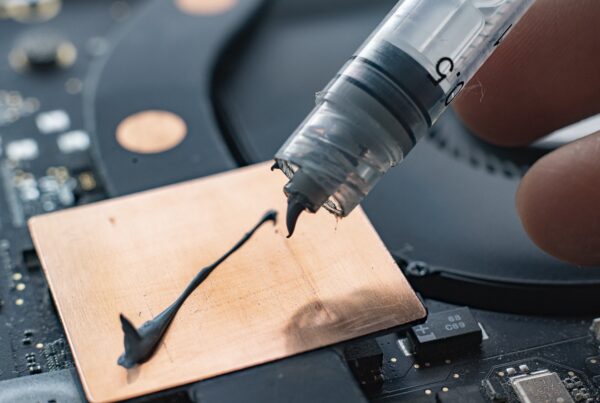Key points of the article
-
Ablative silicone materials protect critical components from extreme heat and mechanical stress. Ablative silicones in the DOWSIL™ range represent high-performance solutions for rockets, missiles, drones, and launch infrastructure.
-
Ablative materials provide wide application flexibility: painting, troweling and spraying.
-
Primer application and surface preparation are critical for optimal adhesion of ablative silicones.
-
Ablative materials ensure effective curing at room temperature, even on pre-existing coatings.
The aerospace and defense faces new technological challenges today, such as reusable rockets, small satellites, drones, hypersonic missiles and mobile rocket launchers. That’s why Mascherpa is following this evolution step by step with its new range of DOWSIL™ ablative silicone materials , designed to create thermal protection system, also known as Thermal Protection System or TPS.
These ablative silicones are designed for application flexibility, ease of use and sustainability, and maximum thermal protection.

The advantages of DOWSIL™ ablative silicones.
With the advancement of innovations and applications in the world of Aerospace, materials whose function is the heat shield of internal and external structures and mechanisms also need innovation. DOWSIL™ ablative silicones to be able to guarantee high performance, even in new technologies, have developed these characteristics:
- Superior performance in high shear stress and high heat flow environments.
- Tenacious carbonization characteristics.
- Thermal stability from -65 °C to +200 °C and for short periods of time at temperatures above 3000 °C.
- Excellent resistance to weathering, moisture, ozone.
- Flexibility in applications.
- Polymerization at room temperature and high temperature.
The different applications of silicone ablative materials
Ablative materials in the DOWSIL™ range can be used for numerous applications:
- In rocket and missile propulsion.
- As a heat shield or thermal protection.
- In the direct or indirect protection of launch infrastructure and deployment facilities.
What is the purpose of the heat shield?
The heat shield is an essential part of space rocket thermal protection and is used to protect critical structures and components from extreme heat and mechanical stresses, such as those generated during launch or atmospheric reentry.
DOWSIL™ ablative silicone products fulfill this function by forming a protective layer that wears off in a controlled manner, dissipating heat and preventing overheating of the underlying surfaces.
Surface preparation
To ensure maximum adhesion and best performance of silicone ablative materials, optimal surface preparation, including cleaning andprimer application, is recommended.
Surface cleaning
To prepare the surface for the application of ablative silicones, we need to start by carefully cleaning the surfaces on which we are going to apply the products. To do this, it is essential to follow the following steps:
- Ensure that all surfaces to be coated with DOWSIL™ ablative silicone are clean and free of dust, dirt, carbon residue , oil or grease. If any of these contaminants are present, the surfaces can be cleaned and degreased with products such as: naphtha, mineral spirits, methyl ethyl ketone (MEK) or other suitable solvents that will remove any oils and other contaminants that may be present.
- Cleaning the substrate with a pressure washer and water will provide enoughsurface abrasion to promote strong adhesion (initial ablative coating or previously coated surfaces).
- Carry out priming with DOWSIL™ Prime Coat materials.
Priming with DOWSIL™ Prime Coat Materials
DOWSIL™ Prime Coat can increasesubstrate surface energy and material wettability, improving adhesion. DOWSIL™ 1200 RTV Prime Coat is recommended in combination with DOWSIL™ 93-104 and DOWSIL™ 3-6077 Ablatives.
DOWSIL™ Prime Coat materials should be applied in a very light, even layer by rubbing, dipping or spraying. Excess material should be removed to avoid over-application that leaves a white, chalky residue on the surface.
When applying DOWSIL™ Prime Coat by dipping or spraying, diluting by a factor of 2 to 4 with additional solvent can prevent excessive buildup.
These primers require moisture in the air to cure. For optimal performance, it is recommended to cure at room temperature in a relative humidity range of 20 to 90 percent for 1 to 2 hours. Low-humidity and/or low-temperature conditions require longer cure times; in these cases, moderate heat can be used to accelerate the primer cure rate.
Very important is to make sure to keep containers of DOWSIL™ Prime Coat tightly closed when not in use in fact, if the primer takes on a “cloudy” appearance in the container, it has likely been exposed to environmental moisture and may not perform as specified.
The application of ablative materials
DOWSIL™ ablative silicones are formulated for flexible application. These materials can be applied by the following methods: painting, troweling or rolling and spraying. Below we present some examples of products and their respective applications:
- DOWSIL™ 93-104 ablative silicone is formulated formanual application at the desired thickness on horizontal surfaces, plus it can be molded into custom parts and shapes.
- The pasty consistency of DOWSIL™ 3-6077 Ablative allows it to be troweled onto horizontal, sloping and vertically opposed surfaces without deforming.
- DOWSIL™ LPA-4000 Sprayable RTV Ablative can also be applied by brush, roller or trowel on both horizontal and vertical surfaces.
- DOWSIL™ LPA-4000 Sprayable RTV Ablative can be sprayed using conventional airless spraying systems. Interchangeable nozzles can be chosen for optimum spray performance on both horizontal and vertical surfaces. This ablative material has shown resistance up to 200 mil without creep.
FAQ
What are ablative materials?
- Ablative materials are coatings designed for thermal protection of surfaces exposed to extreme temperatures, consuming in a controlled manner (ablation) to dissipate heat and reduce heat transfer. DOWSIL™ ablative silicones offer high thermal resistance, excellent adhesion and application flexibility, making them ideal for aerospace and defense applications such as rockets, missiles and launch infrastructure.
How is the thickness of the application determined?
- Application thickness depends on several variables, including the type of ablative silicone applied, location relative to flame impact, and type of fuel. DOWSIL™ 93-104 ablative is recommended for direct impact (flame deflection screens, flame trench throat). DOWSIL™ 3-6077 Ab lative and DOWSIL™ LPA-4000 Sprayable RTV Ablative are recommended for thermal protection of peripheral structures (support structure, gantry). it is recommended to field test the choice of ablative and application thickness to validate the assumptions of structure protection.
Is a primer necessary for ablative silicone adhesion?
- The adhesion of ablative silicone to the substrate is critical for proper structural protection. Adhesion can be optimized by using a compatible silicone primer to increase surface energy on the substrate. DOWSIL™ 1200 primer is versatile and works well with DOWSIL™ silicone ablatives.
Is heat necessary to cure DOWSIL™ ablative silicones?
- Heat is not necessary as they cure deeply at room temperature. Polymerization of DOWSIL™ 93-104 ablatives can be greatly accelerated with heat, but they typically cure fully at room temperature, between 24 and 48 hours, depending on the thickness of the application.
Are there requirements for personal protective equipment (PPE) when applying DOWSIL™ ablative silicones?
- PPE requirements include the use of gloves and goggles. Respirators are generally not required during application. It is recommended that company requirements for PPE be followed when mixing and applying DOWSIL™ ablative silicones.
Can ablative materials be applied to surfaces that already contain cured ablative coatings?
- DOWSIL™ silicone ablatives can be applied to previously coated surfaces. However, it is necessary to ensure that the surface is free of charred residues, loose impediments or other surface residues that could adversely affect adhesion. When applying
Advanced protection for aerospace thanks to DOWSIL™ ablative materials.
The DOWSIL™ range of ablative silicone materials represents a concrete and evolved response to the increasingly complex requirements of the aerospace and defense industry. With their application versatility, high thermal and mechanical performance, and ease of use, these ablative silicones offer reliable solutions for thermal protection of critical structures and components, even under the most extreme conditions.
To identify the best product for your project and receive technical support on application, priming and surface preparation processes, contact Mascherpa experts. Our team is available to walk you through the selection and integration of DOWSIL™ ablative materials with a tailored, innovation-driven approach.



